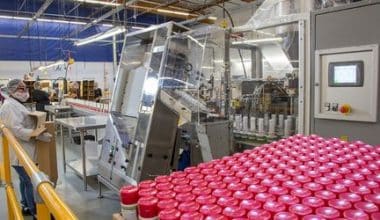Fulfillment by Amazon (FBA) is a storage and delivery service that Amazon provides to help business owners sell their products. Companies ship their products to Amazon’s fulfillment centers, which are specifically intended for FBA services. The products are then received, picked, and packed in the center by Amazon before being shipped to the consumer. Returns, refunds, and customer support are also handled after the sale.
What is an Amazon FBA Business?
An Amazon FBA business allows you to choose what goods to sell, choose a supplier, order the products, package, and ship. One of Amazon’s several Fulfillment Centers serves as the hub for everything, and they handle the rest. (It’s a little different from being an Amazon Affiliate.)
While it has its advantages and disadvantages, as well as numerous aspects to comprehend as a seller, the FBA business model is rather appealing, especially when discussed in great depth.
How Does the Amazon FBA Process Work?
Anyone with an Amazon seller account can delegate all shipping, including returns and refunds, as well as product warehousing in Amazon’s warehouses, selecting and packaging, and other services to Amazon.
Sellers deliver their own products to Amazon, which warehouses everything and then processes the orders as they come in. The rest is done for you as long as you handle the sales and ensure that Amazon is stocked with your products.
Amazon FBA Benefits
While this isn’t a complete list, here are some of the key characteristics that stick out about the Amazon FBA program:
#1. Scalability and logistical support.
Amazon does all the work for you with FBA. FBA enables third-party sellers to outsource their packing, shipping, and customer service to Amazon’s fulfillment network rather than handling logistics from their homes or offices.
With a modest charge, you can remove a tremendous burden from your shoulders.
#2. Enjoy all of the advantages of Amazon Prime.
Items in FBA are automatically assigned the Prime member badge and are eligible for Prime free shipping to the customer as well as expedited shipping timeframes.
Furthermore, because it is included in the service, you will not have to pay or charge premium shipping charges to do so.
#3. Win the Buy Box.
The Amazon Buy Box is the box on the right side of product listings that says “Add to Cart” or “Buy Now.” For merchants, convincing Amazon shoppers to click on those boxes is important, especially because more than 80% of Amazon sales occur through it.
Merchants who use FBA receive access to the Buy Box and all of its perks.
#4. Discounts on shipping costs.
Because you’re working with Amazon, a global fulfillment behemoth, you’ll also save money on shipping through the FBA platform.
As a result, even if you pay Amazon FBA fees, they may be lower than you think when you include delivery savings, and still less expensive than handling your own shipping plans and fulfillment in-house.
#5. 24/7 client service.
For FBA sellers, Amazon provides its own 24-hour customer assistance. You can also use their FBA platform to handle customer service, putting all of your services through a single platform for easier management.
#6. Greater storage space.
How much inventory could you possibly store without FBA? Do you own a warehouse or have the means to rent one? Are you capable of moving and handling that much inventory?
The Fulfillment by Amazon program excels in this regard. Because Amazon has warehouses all across the country that can hold a large number of items, Amazon merchants have access to infinite storage space for a fee.
#7. Fulfillment via various channels.
FBA not only enables you to sell to specific clients via the Amazon platform, but it also grants you access to new multi-channel fulfillment solutions.
Amazon Multi-Channel Fulfillment (MCF) allows you to sell your FBA products on other platforms and channels — such as BigCommerce and eBay — while still having Amazon fulfill them.
Read Also: WHAT TO SELL ON AMAZON AND HOW TO FIND THEM
Amazon FBA Drawbacks
Because no two people are the same, it’s critical to consider the reasons why FBA services might not be the best fit for your requirements. These are some things to think about:
#1. It can be expensive.
FBA is a convenient service, but it is not free. That is money that some folks may not be able to spend right now.
Also, because of the way fees are computed, this service is not suitable for low-cost items, so you should be picky about the products you enroll in. Fortunately, Amazon has a handy FBA calculator that can help you see whether it’s a profitable move.
#2. Needs ongoing inventory management.
Amazon provides a set of requirements for products entering the warehouse to be fulfilled via FBA.
You must verify that your products are properly prepared before delivering them to Amazon, including how they are packaged, correct labeling, and shipment in accordance with the FBA inventory warehousing rules.
#3. Limited branding
Because Amazon packs and ships your products from its fulfillment facilities, you will likely have limited branding opportunities.
If you use Amazon’s fulfillment center, the shipping boxes they use will invariably be branded with their emblem. Even if you have control over the internal packaging of your goods, the first thing shoppers will notice is that the package is from Amazon.
#4. Commingling.
Amazon combines products from numerous third-party sellers with the same manufacturer ID. In essence, they are combining like products.
Amazon uses commingling to boost fulfillment efficiency. While this is advantageous for Amazon, it may result in their products being mixed in with low-quality items from less competent sellers.
#5. More returns.
In many cases, sellers have noticed an increase in the quantity or frequency of returns. This is due, in part, to Amazon’s open return policy.
However, Amazon currently handles the processing. While they used to have returns shipped back to them, and you had to arrange for them to be routed to you, Amazon now permits returns to be sent directly back to your facility.
How Much Does Amazon FBA Cost?
The expense is the bit that everyone always wants to skip over. It will cost money, but it doesn’t have to be a small fortune.
Before selecting Amazon FBA, keep the following costs in mind:
Dangerous vs. non-dangerous commodities.
Before you may sell on Amazon FBA, you must determine if the items you’re selling are classified as dangerous or non-threatening.
Dangerous or Hazmat items are ones that may include hazardous or flammable components. Aside from illegal explosives and weapons, some examples are battery-powered lithium devices, items containing non-harmful compounds, and magnetic objects.
If the things you sell are considered to be dangerous goods, the price difference between them and a non-dangerous item will be substantial, from fulfillment expenses to storage fees.
Fulfillment fees.
Picking and packaging orders, shipping and handling, customer assistance, and product returns are all included in fulfillment fees. The weights and dimensions of your products also affect the fees.
There are two basic categories of FBA fulfillment fees, non-apparel and apparel, with pricing disparities to match.
- Non-apparel: The cost of fulfillment varies from $3.07 per item for small-standard items to $161.11 per item for special gigantic items, depending on the size of your product and the peak rate.
- Apparel: The cost of garment products is quite similar, ranging from $3.43 to $161.11.
Inventory storage costs.
Amazon charges monthly inventory storage fees depending on the daily average volume of merchandise stored in Amazon fulfillment centers.
| Month | Standard Size | Oversize |
| January – September | $0.75 per cubic foot | $0.48 per cubic foot |
| October – December | $2.40 per cubic foot | $1.20 per cubic foot. |
Long-term Storage Fees
Once your product has been in a fulfillment center for more than a year, you will begin to be charged a monthly long-term storage cost.
This price will consist of either $6.90 per cubic foot or $0.15 per unit, whichever is greater.
Inventory health report.
An Inventory Health Report is a report issued by Amazon that gives FBA and other sellers a detailed overview of their inventory, competitive pricing ranges, and other essential information.
With an Inventory Performance Index (IPI) score, the health report is intended to assist FBA sellers in optimizing their inventory and lowering expenses.
Should You Make Use of Amazon FBA?
After reading all of the facts, you must decide whether Amazon FBA is a good idea for your business.
To be clear, Amazon is a competitive marketplace regardless of the goods or services you intend to sell. But, the chances present are hard to pass up for forward-thinking companies – especially those just getting started.
Using an existing established fulfillment program and infrastructure, as well as resources like Amazon Seller Central, can make the most difficult half of the process worthwhile in the end.
Amazon FBA vs. Seller-Fulfilled Prime
For individuals who wish to leverage the valuable Prime client base but don’t want to pay the FBA program costs, there is the option to create a Seller-Fulfilled Prime (SFP) account where you can sell, fulfill, and search products and orders.
While FBA charges fractional fees for storage and fulfillment, Seller-Fulfilled Prime requires you to cover all shipping costs, which might eat into your profit margins. Yet, these expenditures are often set and do not fluctuate.
Inventory storage and control are also in your hands with FBA; you deliver your goods to Amazon, and they take care of the rest. When you utilize SFP, you must manage your inventory, choose a storage location, pay for storage, and more. The fulfillment logistics are entirely at your disposal and can be challenging for everyone.
SFP will certainly be more work, so small companies and new sellers do better with the FBA program. SFP is an excellent option to earn the Prime badge while keeping your prices down if you have low-cost items, huge items that would incur expensive storage fees with Amazon, or a mature fulfillment process.
Read Also: HOW TO START AN AMAZON BUSINESS IN 2023: Step-By-Step Guide
How to Maximize FBA Sales
There is a wealth of information available to assist you to boost your FBA sales from the start. If you want to enhance your revenues and simplify your growth by employing this service, here are a few ideas and methods to keep in mind:
#1. Make use of online analytics tools.
Utilize web analytics tools to find the most profitable and popular things on Amazon and discover the best product categories to sell in.
See what the best-sellers are doing and take notes.
#2. Be smart about your product selection.
Consider not only your sales rank but also what you earn in return.
High-ranking Amazon products are competitive, but they sell rapidly and keep inventory moving. Low-ranking products may result in stagnant inventories and long-term fees. Yet, because there is less competition, they may allow you to become a major seller.
#3. Where possible, group goods together.
One of the most difficult aspects of Amazon selling is competing with dozens of near-identical listings that may differ by a couple of reviews or a few dollars in price but are otherwise indistinguishable.
Businesses can distinguish themselves by producing packaged Amazon listings that attract people’s attention and provide greater value for their money.
#4. Develop your brand.
Businesses must take the time to build a brand step by step and place it in a position to succeed and reach its target audience. It’s not just about being in the buy box. It is essential to sell high-quality products that have been sourced from a recognized manufacturer or distributor.
It would be ideal if you also received positive feedback to guarantee that your metrics qualify you for the buy box and maximize your sales prospects.
#5. Reply to customers as soon as possible.
One of the most important aspects in choosing a seller on Amazon is how well they reply and engage when provoked.
If a user asks a question, respond quickly and nicely to let everyone know you’re available when they need you.
Using Amazon FBA Correctly
Fulfillment by Amazon, like everything else, only works if you integrate and use it correctly. To accomplish this, you must adhere to some best practices and general themes, such as:
#1. Start small.
You don’t have to sell everything, and you shouldn’t.
Note that Amazon FBA incurs charges for storage and warehousing. Consider attempting a few goods and working your way into different products as time goes on until you know what will sell.
Select a well-cultivated selection of things and list them through FBA so that you have a slightly simpler time learning the best practices when first starting.
#2. Choose your products carefully.
As noted before, you must be very careful in product selection. Just because you believe something will sell does not guarantee that it will.
The market is competitive on Amazon, and you must choose the most profitable things to avoid stagnating inventory – allowing your products to stand out even if they are not the top-selling commodities.
Conclusion
Ultimately, Amazon’s FBA program is a complete fulfillment scheme that can assist practically any business sell their items and making a profit. To determine whether Fulfillment by Amazon might be a suitable fit for you, consider the number of sales orders you receive, the number of staff you have, and the type of products you sell.
- HOW TO START AN AMAZON BUSINESS IN 2023: Step-By-Step Guide
- AMAZON AUTOMATION: Overview, Scam, Investments, Store
- FULFILLMENT CENTER: Meaning And Its Benefit To Small Businesses
- How To Be An Amazon Seller: Best 2023 US Practices & All You Need
- AMAZON RESELL: How To Start Reselling On Amazon






